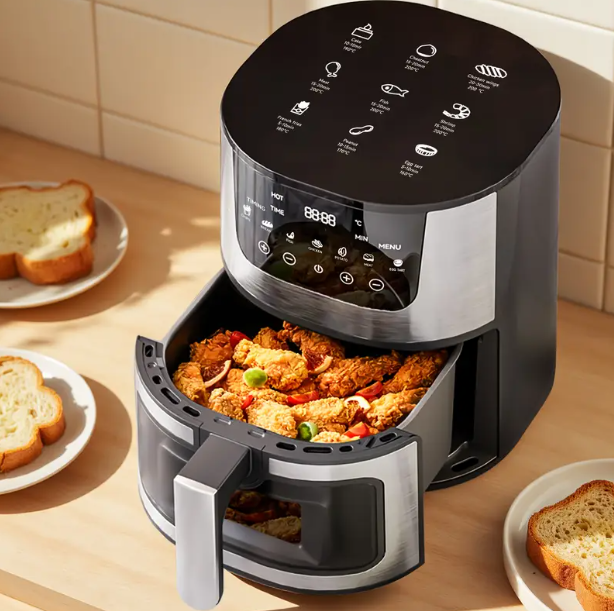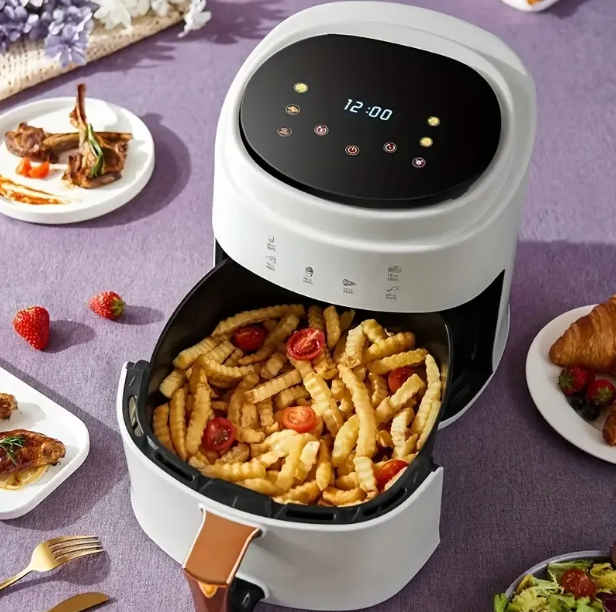Hello, fellow food lovers! Chef Airkit here, straight from the Airkit Home test kitchen. I still remember the day I unboxed my first air fryer. It was this sleek, promising machine, and I had visions of perfectly crispy fries and guilt-free chicken wings dancing in my head. But let’s be real—my first batch of fries was… a little sad. Some were burnt, some were soggy. It was then I realized that this amazing appliance has its own set of rules. That’s why I’ve gathered all the best Air Fryer Hacks And Tips to help you skip the learning curve and jump straight to delicious, consistent results. Are you ready to unlock your air fryer’s full potential? Let’s dive in.

Before You Even Cook: The Prep Hacks That Matter
Great results start long before the food hits the basket. Think of this as laying the foundation for a crispy, golden-brown masterpiece. Getting these simple steps right will fundamentally change your air frying game.
Why Preheating Is a Non-Negotiable
Ever wonder why some recipes call for preheating while others don’t? Let me settle the debate for you: always preheat. An air fryer is essentially a small, high-powered convection oven. Hitting your food with hot, circulating air from the get-go is the secret to that coveted crispy exterior.
Think of it like searing a steak in a hot pan. You wouldn’t toss it into a cold skillet, would you? The same principle applies here. Preheating for just 3-5 minutes ensures the cooking process starts immediately, preventing food from steaming in its own moisture and turning soggy. Most modern air fryers, like our Airkit Home Pro model, have a preheat function, but if yours doesn’t, just run it empty at your desired temperature for a few minutes.
Don’t Crowd the Basket!
This is probably the single most common mistake I see. It’s tempting to pile everything in to save time, but you’ll pay the price in texture. The magic of an air fryer lies in its ability to circulate hot air around each piece of food. When you overcrowd the basket, you create a steamy, humid environment instead of a dry, hot one.
- The Golden Rule: Cook in a single, even layer.
- For Best Results: Leave a little space between each item.
- Working with a Big Batch? It’s far better to cook in two smaller batches than one giant, crowded one. Your patience will be rewarded with superior crispiness.
The Magic of a Little Oil (and When to Avoid Aerosols)
While “oil-free” is a big selling point, a tiny bit of oil is your best friend for achieving that deep-fried flavor and texture. It helps with the Maillard reaction, the chemical process that gives browned food its distinctive flavor.
However, put down that aerosol cooking spray! Many commercial sprays contain propellants and emulsifiers that can damage the non-stick coating on your air fryer basket over time. Instead, invest in an oil mister or simply toss your food in a bowl with a teaspoon of a high-smoke-point oil like avocado, grapeseed, or light olive oil before cooking.
Next-Level Cooking: Air Fryer Hacks and Tips for Perfect Results
Once your prep is perfect, it’s time to focus on the cooking process itself. These in-the-moment adjustments are what separate the amateurs from the air-frying pros.
Shake, Rattle, and Roll (or Flip)
Your air fryer’s heating element is at the top, meaning the food closest to it will cook and brown faster. To ensure everything cooks evenly, you need to redistribute the food halfway through the cooking time.
- For smaller items (fries, veggies, chicken nuggets): Vigorously shake the basket.
- For larger items (chicken breasts, fish fillets, burger patties): Use tongs to flip them over.
This simple step guarantees that all sides get equal exposure to the hot air, preventing the dreaded “crispy on top, pale on the bottom” syndrome.
Taming the Smoke Monster: How to Prevent a Smoky Kitchen
Cooking fatty foods like bacon, burgers, or chicken thighs can sometimes trigger your smoke alarm. This happens when grease drips down and burns on the hot surface below the basket. But don’t worry, there’s an easy fix.
Pro Tip: Place a piece of bread or a couple of tablespoons of water in the drawer underneath the basket.
The bread will soak up the excess grease, while the water prevents the drippings from smoking when they hit the hot pan. It’s a simple, brilliant hack that keeps your kitchen air clear.
The “Dry Brine” for Ultimate Crispiness
Moisture is the enemy of crispiness. Before you season or oil your food, especially things like chicken wings or potato wedges, pat them thoroughly dry with a paper towel. Removing surface moisture allows the exterior to dehydrate and crisp up much faster.
For an extra crunch, try a light dusting of cornstarch or baking powder (for chicken wings) along with your seasonings. This creates a dry, porous surface that crisps up beautifully in the hot air. You can learn more about this technique in our ultimate guide to crispy air fryer chicken.
What Can You Actually Cook in an Air Fryer?
You can cook almost anything in an air fryer that you would bake, roast, or fry. It excels at cooking frozen foods, roasting vegetables, and reheating leftovers to their original glory, but its capabilities extend far beyond that to include baking small cakes, making “hard-boiled” eggs, and even toasting sandwiches.
As kitchen appliance expert, Sarah Jenkins, notes, “People initially buy an air fryer for healthier French fries, but they quickly discover it’s the most versatile tool in their kitchen. From weeknight roasted broccoli to perfectly reheated pizza, it streamlines cooking and delivers incredible texture that a microwave simply can’t match.”
A Quick Guide to Common Foods
Here’s a handy table to get you started. Remember, all air fryers are slightly different, so consider this a starting point and adjust as needed.
| Food Item | Temperature (°F) | Temperature (°C) | Time (Minutes) | Notes |
|---|---|---|---|---|
| French Fries (Frozen) | 400°F | 200°C | 15-20 | Shake halfway |
| Chicken Wings | 380°F | 190°C | 20-25 | Flip halfway |
| Brussels Sprouts | 375°F | 190°C | 15-18 | Shake halfway |
| Salmon Fillet | 400°F | 200°C | 7-10 | Don’t overcrowd |
| Chicken Breast | 370°F | 185°C | 18-22 | Flip halfway |
| Reheating Pizza | 350°F | 175°C | 3-5 | Crisps crust perfectly |
Cleaning Made Easy: Your Post-Cooking Checklist
A clean air fryer is a happy and efficient air fryer. Caked-on grease can smoke and impart off-flavors to your food. Follow this simple checklist after each use.
- [ ] Unplug the Unit: Safety first! Let it cool down for at least 30 minutes.
- [ ] Empty the Drawer: Dispose of any crumbs or excess oil from the bottom pan.
- [ ] Soak Immediately (If Needed): If there’s stuck-on food, fill the basket and drawer with hot, soapy water and let it sit for 10 minutes. This does 90% of the work for you.
- [ ] Wash Gently: Use a non-abrasive sponge to wash the basket and drawer. Most are dishwasher-safe (check your manual!), but a quick hand wash is often faster.
- [ ] Wipe Down the Interior: Use a damp cloth to wipe the inside of the main unit, including around the heating element.
- [ ] Dry Completely: Make sure all parts are completely dry before reassembling to prevent rust and odors.

Frequently Asked Questions (FAQ)
Here are answers to some of the most common questions we get at Airkit Home.
Can I use aluminum foil or parchment paper in my air fryer?
Yes, you can, but with caution. Place it inside the basket, never underneath it where it can block airflow. Always ensure the food weighs the paper or foil down so it doesn’t fly up and hit the heating element, which is a fire hazard. There are also special perforated parchment liners made specifically for Air Fryers.
Do I really need to preheat my air fryer for everything?
For the best, crispiest results, yes. Preheating ensures your food starts cooking at the right temperature immediately. The only exception might be for very delicate items or some baked goods, but for 95% of your cooking, a 3-5 minute preheat is a non-negotiable step.
How do I cook fatty foods like bacon without my kitchen filling with smoke?
The key is to manage the grease. You can add a couple of tablespoons of water or a slice of bread to the drawer underneath the basket. This catches the dripping grease and prevents it from getting hot enough to smoke.
What is the best oil to use in an air fryer?
You want an oil with a high smoke point. Avocado oil, grapeseed oil, peanut oil, and light olive oil are all excellent choices. Avoid oils with low smoke points like extra virgin olive oil for high-temperature cooking, as they can burn and create an unpleasant taste.
Why is my food coming out dry instead of crispy?
This usually happens for one of two reasons: you’ve cooked it for too long, or you didn’t use any oil. A very light coating of oil helps to brown the exterior and lock in moisture. Also, be sure to check your food a few minutes before the recipe suggests, as cooking times can vary between machines.
Your Crispy Adventure Awaits
And there you have it! With these foundational air fryer hacks and tips, you’re no longer just an owner of an air fryer; you’re the pilot. You have the knowledge to control the variables—heat, air, oil, and space—to create consistently delicious and healthy meals. The real joy of the air fryer is its ability to transform everyday ingredients into something special with minimal fuss.
So go on, experiment with that vegetable you thought you hated, perfectly reheat last night’s pizza, or master the art of the crispy chicken wing. We can’t wait to see what you create.